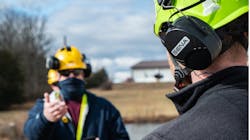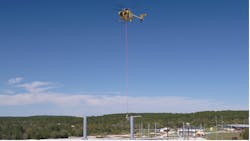Keeping Utility Lineworkers Safe with Wireless Mesh Technology
“Imagine a lineworker’s first transfer from a helicopter skid to a transmission tower,” said Stan Robertson, an instructor with Northwest Lineman College (NLC). “You’re 80 ft in the air. The helicopter is loud, and you’re standing on a 2-in. piece of pipe, getting ready to stand on an even smaller piece of metal on a transmission tower. No matter how much classroom training you’ve done, everything you’ve been taught is put to the test in that moment.”
Robertson provides aviation training for aerial lineworkers working on transmission towers and poles via helicopter. Northwest Lineman College, with four campuses across the United States, trains thousands of workers at every stage of their career both on-campus and at customer sites via their Mobile Training Division. The college started offering the aviation classes in 2020, and are one of the few to provide this type of training.
Good communication is essential for lineworkers, who literally put their lives on the line to keep the power on for homes and businesses. During aerial training, Robertson says it really helps the student to hear the voice of the trainer via a wireless Mesh headset. “I can say, ‘OK, you’re going to put your foot here. You’re going to put your lanyard there.’ It creates a calm learning environment.”
Wireless Mesh headsets are emerging as a communication tool for utility workers. NLC uses Tufftalk M headsets made by Sena Industrial that use the Bluetooth frequency around 2.4 GHz and have a range of 0.7 miles. Noise-cancelling technology and high-definition digital sound provide clear communication. The headsets have built-in hearing protection rated at 24-decibel reduction on the helmet-mounted version.
As a trainer, Robertson appreciates that the headsets are easy to move from helmet to helmet. He said the students learn better because he can talk to them while they’re in position practicing work. Before using the headsets, trainers would have to demonstrate actions, then communicate, “OK, your turn,” and then rely on head signals and pointing, a method prone to miscommunication in a training environment. With students long-lining 100 ft below a helicopter, it’s difficult for pilots to see and understand head movements and hand signals.
On the job site, Robertson had previously used two-way radios to communicate, which also had drawbacks. They were hard to hear while wearing hearing protection. On the skid, and even on the short line within 50 ft of the helicopter, he found that the noise of the rotors was so loud that the radio wasn’t useable. On the long line, the helicopter noise decreased enough that radio conversations could take place, but if the helicopter was flying fast, then all he could hear was wind noise.
The biggest issue of two-way radios is the limitation of half-duplex technology. Only one person can speak at a time, and users must press a button to talk. While transferring to and from a tower or pole, it’s essential for workers to have both hands on task, with no distractions.
Good communication is critical for both the student and the pilot. Wireless Mesh headsets let the trainer, the student, and the pilot talk to each other simultaneously and without the muffled sound of radios.
The Mesh technology allows a virtually unlimited number of users. Because each device on a Mesh network can route the signal to the next device, the range can extend to a large work area. In the case of the Tufftalk M headsets, which use Sena’s proprietary Mesh Intercom protocol, the range can extend to more than two miles in open air, depending on the devices in the network. Large work-area coverage and a high number of devices make the headsets useful in powerline maintenance work.
Robertson said the industry is typically resistant to something new, and at first students didn’t want something more to add to their helmet and to learn how to use. However, once students and pilots use the headsets, the reviews have only been positive. “Being able to talk to them through the training process is pretty awesome,” he said. Furthermore, once students complete training with the headsets they become advocates for the safety benefits of their use on future job sites.
About the Author
Chris Clarke
Chris Clarke is an Industrial Communications Consultant at Sena Industrial. Sena Technologies specializes in Bluetooth communication and created the Mesh Intercom system. To learn more about Sena communication solutions with integrated hearing protection, visit senaindustrial.com.

